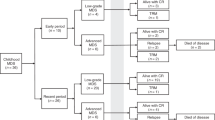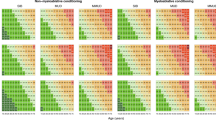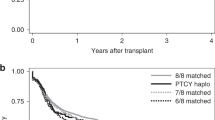Abstract
Allogeneic hematopoietic stem cell transplantation (HSCT) is considered the only a curative treatment in patients with higher risk myelodysplastic syndrome (MDS), although demethylating agents (DMA) have been reported to improve survival. The advantage of HSCT over other treatment comes from retrospective studies and the aim of the current study was to prospectively test this hypothesis, analyzing in particular patients from the pre-transplant period to avoid the selection bias of performing transplantation. This study was conducted to compare overall survival in MDS patients candidates to transplantation according to donor availability. The majority of patients (76%) received a treatment with DMA after registration, 69% had a human leukocyte antigen (HLA)-identical donor, 70% of whom were transplanted. Baseline patient and disease characteristics were similar according to donor availability. Four-year overall survival was significantly better in patients with an HLA matched donor (37%) compared to patients without donor (15%). There was also evidence that this overall survival advantage was because of transplantation. Mortality risk was decreased after transplantation but it became significant only after the second year post transplant, because of early transplant-related mortality. Our results appear to justify, in higher risk MDS, a transplantation approach in all potential candidates who have an HLA identical donor.
This is a preview of subscription content, access via your institution
Access options
Subscribe to this journal
Receive 12 print issues and online access
$259.00 per year
only $21.58 per issue
Buy this article
- Purchase on Springer Link
- Instant access to full article PDF
Prices may be subject to local taxes which are calculated during checkout


Similar content being viewed by others
References
Greenberg P, Cox C, LeBeau MM, Fenaux P, Morel P, Sanz G et al. Scoring system for evaluating prognosis in myelodysplastic syndromes. Blood 1997; 89: 2079–2088.
Greenberg, PL, Tuechler H, Schanz J, Sanz G, Garcia-Manero G, Sole f et al. Revised international prognostic scoring system for myelodysplastic syndromes. Blood 2012; 120: 2454–2465.
Cutler CS, Lee SJ, Greenberg P, Deeg HJ, Perez WS, Anasetti C et al. A decision analysis of allogeneic bone marrow transplantation for the myelodysplastic syndromes: delayed transplantation for low-risk myelodysplasia is associated with improved outcome. Blood 2004; 104: 579–585.
Koreth J, Pidala J, Perez WS, Deeg HJ, Garcia-Manero G, Malcovati L et al. Role of reduced-intensity conditioning allogeneic hematopoietic stem-cell transplantation in older patients with de novo myelodysplastic syndromes: an international collaborative decision analysis. J Clin Oncol 2013; 31: 2662–2670.
Platzbecker U, Schetelig J, Finke J, Trenschel R, Scott BL, Kobbe G et al. Allogeneic hematopoietic cell transplantation in patients age 60-70 years with de novo high-risk myelodysplastic syndrome or secondary acute myelogenous leukemia: comparison with patients lacking donors who received azacitidine. Biol Blood Marrow Transplant 2012; 18: 1415–1421.
Brand R, Putter H, van Biezen A, Niederwieser D, Martino R, Mufti G et al. Comparison of allogeneic stem cell transplantation and non-transplant approaches in elderly patients with advanced myelodysplastic syndrome: optimal statistical approaches and a critical appraisal of clinical results using non-randomized data. PLoS One 2013; 8: e74368.
Sierra J, Perez WS, Rozman C, Carreras E, Klein JP, Rizzo GD et al. Bone marrow transplantation from HLA-identical siblings as treatment for myelodysplasia. Blood 2002; 100: 1997–2004.
Guardiola P, Runde V, Bacigalupo A, Ruutu T, Locatelli F, Boogaerts MA et al. Retrospective comparison of bone marrow and granulocyte colony-stimulating factor-mobilized peripheral blood progenitor cells for allogeneic stem cell transplantation using HLA identical sibling donors in myelodysplastic syndromes. Blood 2002; 99: 4370–4378.
de Lima M, Anagnostopoulos A, Munsell M, Shahjahan M, Ueno N, Ippoliti C et al. Nonablative versus reduced-intensity conditioning regimens in the treatment of acute myeloid leukemia and high-risk myelodysplastic syndrome: dose is relevant for long-term disease control after allogeneic hematopoietic stem cell transplantation. Blood 2004; 104: 865–872.
Scott BL, Sandmaier BM, Storer B, Maris MB, Sorror ML, Maloney DG et al. Myeloablative vs nonmyeloablative allogeneic transplantation for patients with myelodysplastic syndrome or acute myelogenous leukemia with multilineage dysplasia: a retrospective analysis. Leukemia 2006; 20: 128–135.
Martino R, Iacobelli S, Brand R, Jansen T, van Biezen A, Finke J et al. Retrospective comparison of reduced-intensity conditioning and conventional high-dose conditioning for allogeneic hematopoietic stem cell transplantation using HLA-identical sibling donors in myelodysplastic syndromes. Blood 2006; 108: 836–846.
Lim Z, Brand R, Martino R, van Biezen A, Finke J, Bacigalupo A et al. Allogeneic hematopoietic stem-cell transplantation for patients 50 years or older with myelodysplastic syndromes or secondary acute myeloid leukemia. J Clin Oncol 2010; 28: 405–411.
Saber W, Le Rademacher J, Sekeres M, Logan B, Lewis M, Mendizabal A et al. Multicenter biologic assignment trial comparing reduced-intensity allogeneic hematopoietic cell transplant to hypomethylating therapy or best supportive care in patients aged 50 to 75 with intermediate-2 and high-risk myelodysplastic syndrome: blood and marrow transplant clinical trials network #1102 study rationale, design, and methods. Biol Blood Marrow Transplant 2014; 20: 1566–1572.
Vardiman JW, Thiele J, Arber DA, Brunning RD, Borowitz MJ, Porwit A et al. The 2008 revision of the World Health Organization (WHO) classification of myeloid neoplasms and acute leukemia: rationale and important changes. Blood 2009; 114: 937–951.
Robins JM, Hernan MA, Brumback B . Marginal structural models and causal inference in epidemiology. Epidemiology 2000; 11: 550–560.
Hernan MA, Brumback B, Robins JM . Marginal structural models to estimate the causal effect of zidovudine on the survival of HIV-positive men. Epidemiology 2000; 11: 561–570.
Cole SR, Hernan MA . Constructing inverse probability weights for marginal structural models. Am J Epidemiol 2008; 168: 656–664.
Robins JM, Finkelstein DM . Correcting for noncompliance and dependent censoring in an AIDS Clinical Trial with inverse probability of censoring weighted (IPCW) log-rank tests. Biometrics 2000; 56: 779–788.
Cole SR, Hernan MA . Adjusted survival curves with inverse probability weights. Comput Methods Programs Biomed 2004; 75: 45–49.
Grambsch P, Therneau T . Proportional hazards tests and diagnostics based on weighted residuals. Biometrika 1994, 515–556.
Kalbfleich J, Prentice R . The Statistical Analysis of Failure Time Data. New York, 1980.
Prentice R, Kalbfleisch J, Peterson A, Flournoy N, Farewell V, Breslow N . The analysis of failure times in the presence of competing risks. Biometrics 1978; 34: 541.
van der Wal W, Geskus R . ipw: an R package for inverse probability weighting. J Stat Softw 2011; 43: 1.
Cheson BD, Greenberg PL, Bennett JM, Lowenberg B, Wijermans PW, Nimer SD et al. Clinical application and proposal for modification of the International Working Group (IWG) response criteria in myelodysplasia. Blood 2006; 108: 419–425.
Patriarca F, Einsele H, Spina F, Bruno B, Isola M, Nozzoli C et al. Allogeneic stem cell transplantation in multiple myeloma relapsed after autograft: a multicenter retrospective study based on donor availability. Biol Blood Marrow Transplant 2012; 18: 617–626.
Sarina B, Castagna L, Farina L, Patriarca F, Benedetti F, Carella AM et al. Allogeneic transplantation improves the overall and progression-free survival of Hodgkin lymphoma patients relapsing after autologous transplantation: a retrospective study based on the time of HLA typing and donor availability. Blood 2010; 115: 3671–3677.
Damaj G, Duhamel A, Robin M, Beguin Y, Michallet M, Mohty M et al. Impact of azacitidine before allogeneic stem-cell transplantation for myelodysplastic syndromes: a study by the Societe Francaise de Greffe de Moelle et de Therapie-Cellulaire and the Groupe-Francophone des Myelodysplasies. J Clin Oncol 2012; 30: 4533–4540.
Alessandrino EP, Della Porta MG, Pascutto C, Bacigalupo A, Rambaldi A . Should cytoreductive treatment be performed before transplantation in patients with high-risk myelodysplastic syndrome? J Clin Oncol 2013; 31: 2761–2762.
de Witte T, Hagemeijer A, Suciu S, Belhabri A, Delforge M, Kobbe G et al. Value of allogeneic versus autologous stem cell transplantation and chemotherapy in patients with myelodysplastic syndromes and secondary acute myeloid leukemia. Final results of a prospective randomized European Intergroup Trial. Haematologica 2010; 95: 1754–1761.
Acknowledgements
We thank members of GFM and SFGM-TC for their participation and support. We thank Alix O’Meara for the English review. We thank Pierre Fabre for their contribution to this study.
Author Contributions
MR, GS, HD, ER, LA and PF designed research, RP and MR analyzed the data; all co-authors performed the research and recruited patients, MR, GS, LA, PF and RP wrote the paper and all authors gave their comments.
Author information
Authors and Affiliations
Corresponding author
Ethics declarations
Competing interests
The authors declare no conflict of interest.
Additional information
Supplementary Information accompanies this paper on the Leukemia website
Supplementary information
Rights and permissions
About this article
Cite this article
Robin, M., Porcher, R., Adès, L. et al. HLA-matched allogeneic stem cell transplantation improves outcome of higher risk myelodysplastic syndrome A prospective study on behalf of SFGM-TC and GFM. Leukemia 29, 1496–1501 (2015). https://doi.org/10.1038/leu.2015.37
Received:
Revised:
Accepted:
Published:
Issue Date:
DOI: https://doi.org/10.1038/leu.2015.37
This article is cited by
-
Peripheral blood haploidentical hematopoietic cell transplantation for patients aged 70 years and over with acute myeloid leukemia or high-risk myelodysplastic syndrome
Bone Marrow Transplantation (2024)
-
Outcomes of transplant-eligible patients with myelodysplastic syndrome with excess blasts registered in an observational study: The JALSG-CS11-MDS-SCT
Annals of Hematology (2024)
-
Are syngeneic donors a viable donor option in allogeneic haematopoietic cell transplantation for MDS? A brief report on behalf of the Chronic Malignancies Working Party of the EBMT and review of current literature
Bone Marrow Transplantation (2023)
-
Outcome after allogeneic stem cell transplantation with haploidentical versus HLA-matched donors in patients with higher-risk MDS
Bone Marrow Transplantation (2023)
-
Fit older adults with advanced myelodysplastic syndromes: who is most likely to benefit from transplant?
Leukemia (2021)



